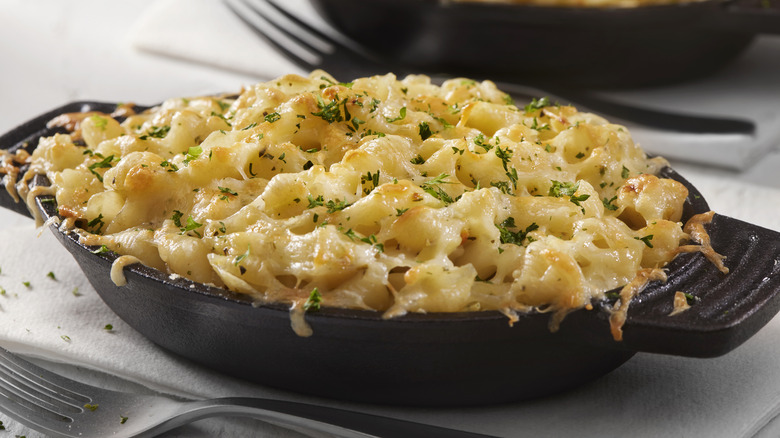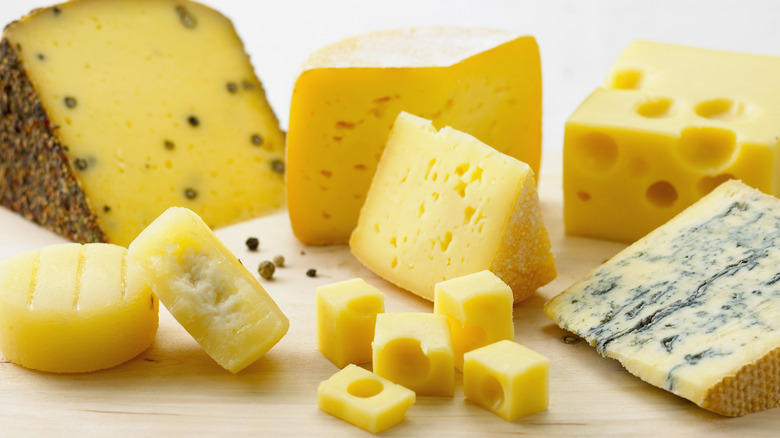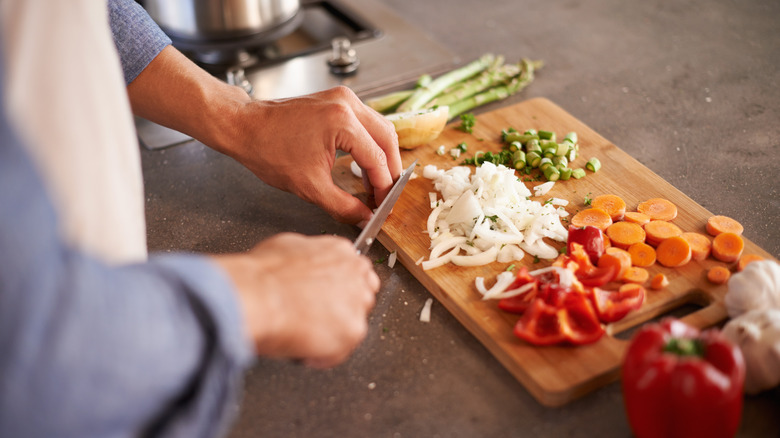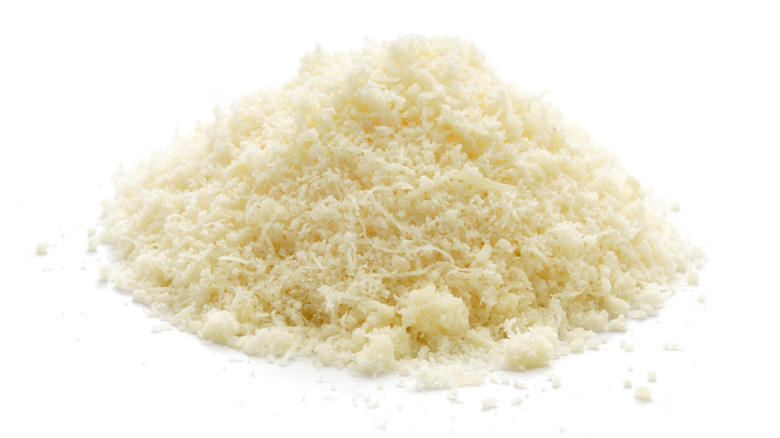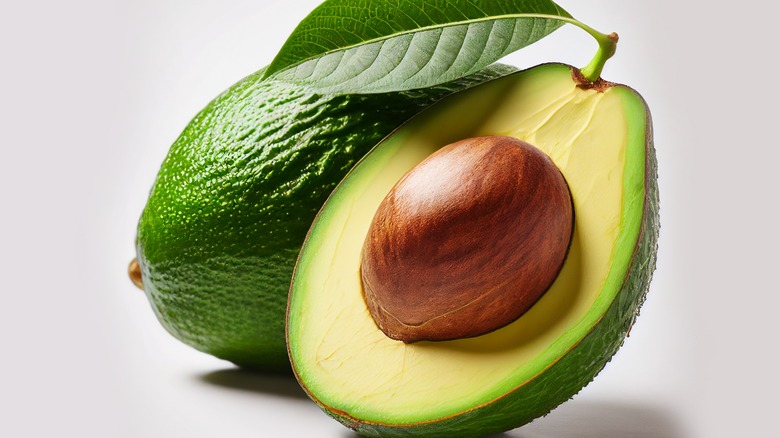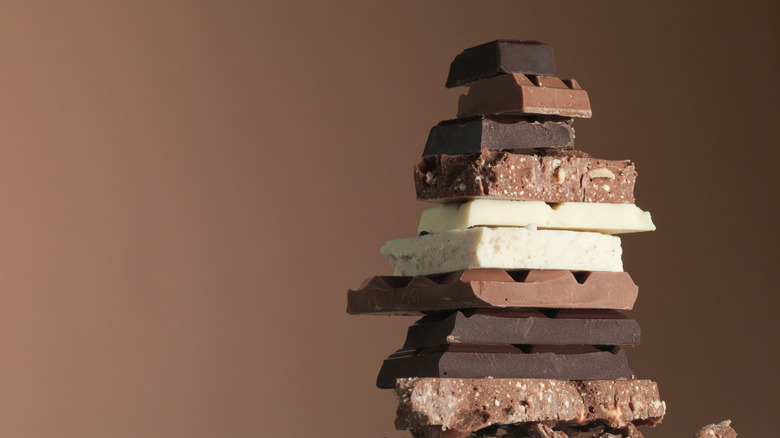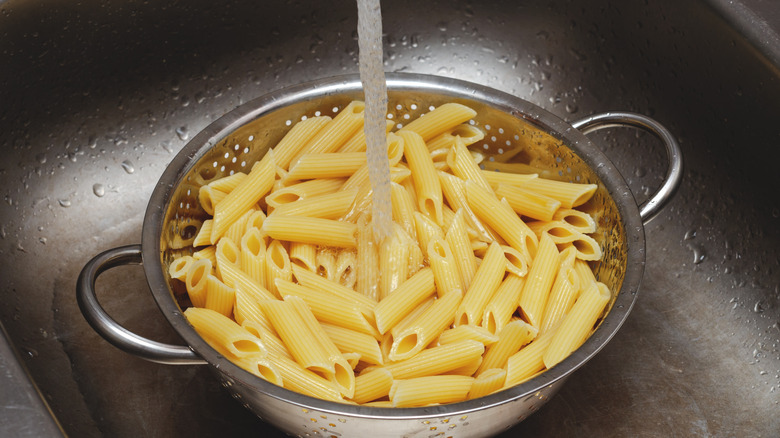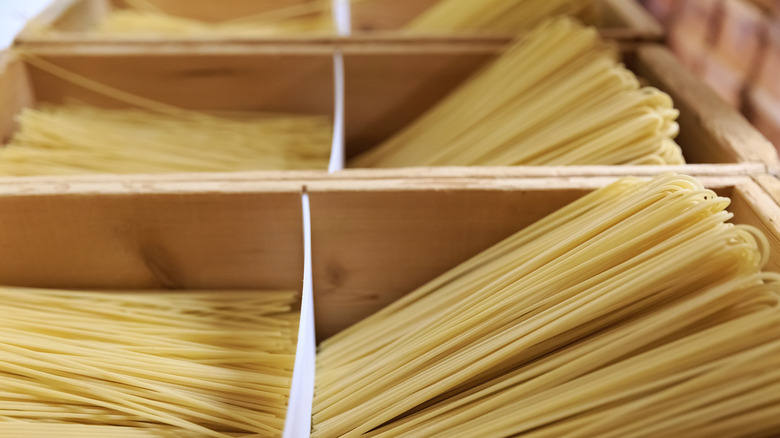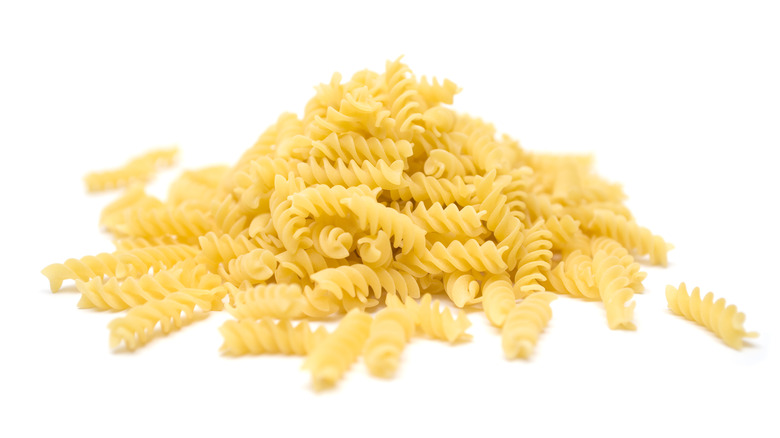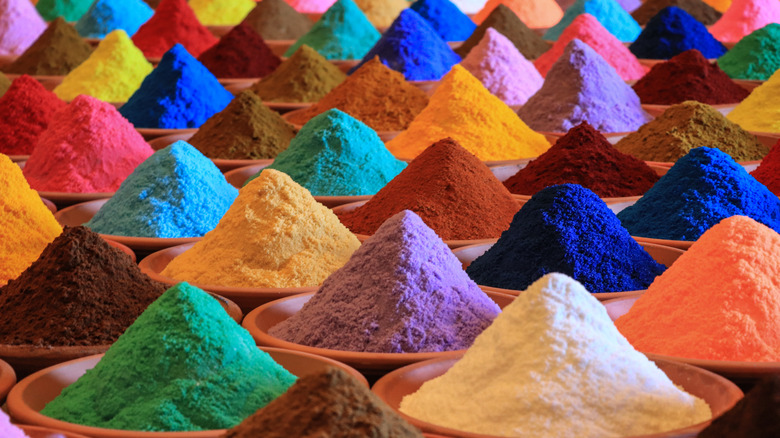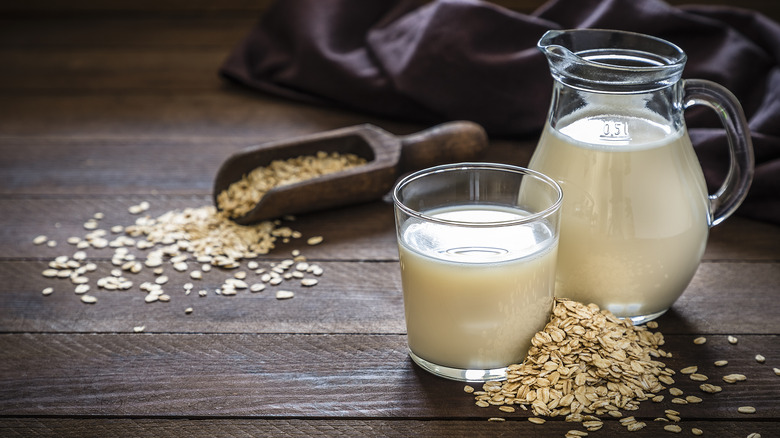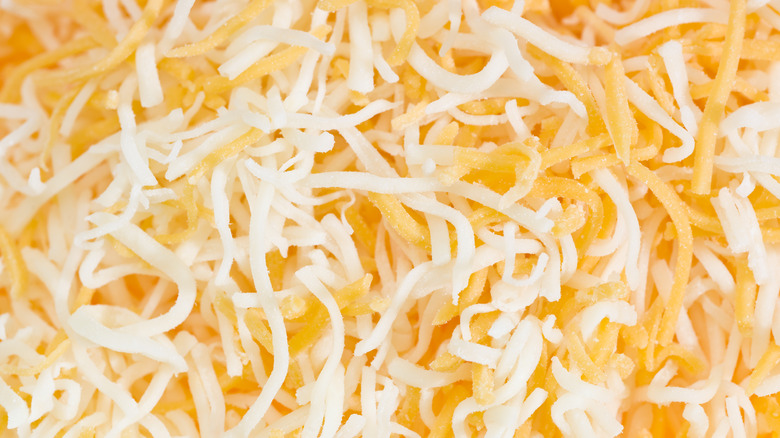12 Ingredients That Don't Belong In Macaroni And Cheese
For most American diners, macaroni and cheese is a dependable favorite. Whether it's rehydrated and heated straight from the box, pulled from the freezer and baked until melty, or lovingly made from scratch with an old family recipe, it's almost sure to be enthusiastically devoured. But, because mac and cheese can be bit bland, curious cooks are often tempted to play with it. This, of course, is a good thing — thanks to culinary curiosity and experimentation, lobster mac and cheese has become a new classic, and tasty variants such as fried mac and cheese balls abound.
But when it comes to the standard mac and cheese — which diners expect to be creamy, mild-mannered, and comforting — there's a line between innovation and desecration, and way too many over-enthusiastic cooks have crossed it. No respectable mac and cheese should be blue or pink or loaded with so many vegetables it changes the dish. Some ingredients, simply put, just don't belong in mac and cheese. So while you should always feel free to innovate in the kitchen, here are some red lines not to cross when trying to switch things up with mac and cheese.
Super-fancy cheeses
One of the most common strategies for switching up mac and cheese is to try to elevate it. For instance, a big mistake some cooks make when switching up their mac and cheese is substituting super-fancy, exotic cheeses for tried-and-true favorites such as Cheddar and American. But, while fancy cheeses are flavorful and enjoyable in their own right, they may not play well with the other ingredients in the dish.
It's fair to say that one absolutely non-negotiable quality in any good mac and cheese is a smooth, creamy cheese sauce, and to get this, you need cheeses that melt evenly without becoming grainy, lumpy, or separated. So while easy-melting cheeses such as gouda, gruyere, and brie (with the rind removed) all add depth and variety as well as creaminess, grainy cheeses such as feta or cotija will just leave weird lumps in your sauce. If you love the flavor they add, use them in your topping instead.
Too many add-ins
It's no secret mac and cheese is a favorite choice of picky children because it's blissfully free of any ingredients they find objectionable, such as strong spices or (eeww!) vegetables. But, these very features are what make some adults a bit jaded about the dish — that monochrome yellow and simple flavor just seem boring and scream for a refresh.
But, while a bit of a chopped jalapeño or a touch of truffle oil can add a welcome change to the familiar flavor profile, mac and cheese was never intended to be a dumping ground for leftovers or a place to showcase anything but its namesake ingredients. The beauty and appeal of mac and cheese is its very simplicity and familiarity. So, unless you want to alienate all your dinner guests, resist the temptation to use it for high-concept experiments (such as incorporating your Thanksgiving Brussels sprouts into the dish). If your muse is truly calling you to put a bunch of vegetables in pasta, make pasta primavera or veggie lasagna instead.
Canned Parmesan
Macaroni and cheese is a simple dish, but simple doesn't always mean easy. And, this can lead to some common pitfalls for less-experienced cooks trying to make it from scratch. Since most cooks associate macaroni and cheese with casual family meals, it's tempting to resort to the shortcuts and cheaper ingredients that busy home cooks often use to good effect. For instance, cooks who want to add the depth and sharpness of Parmesan to their dish are often tempted to buy a cardboard cylinder of the pre-grated stuff — it's cheap, and will save a few minutes of grating time.
This sounds good in theory, but unfortunately doesn't work in practice because the flavor profile of mac and cheese is so basic, every ingredient has to count: If it doesn't contribute to the dish's desired texture, creaminess, or flavor, it has no place in your recipe. Not only is pre-grated Parmesan dull-tasting, it stubbornly resists melting if you put it in your sauce. Instead, it'll leave your sauce grainy and off-putting. Parmesan can be a great add-in, but if you use it, lean fully into the cooking-from-scratch experience and grate your own – you won't regret it.
Huge amounts of booze
Followers of the early seasons of "The Great British Baking Show" quickly figured out that an easy way to get extra love from then-judge Mary Berry was to generously lace your bakes with booze. And, we all know how a touch of wine, vermouth, or other alcoholic drink can add depth and sophistication to otherwise basic savory dishes. For example, beer (in reasonable quantities) can be easily incorporated into macaroni and cheese, where it takes the place of some of the milk in the cheese sauce base. This turns the dish into a tempting love child between basic mac and cheese and a Welsh rarebit.
But, too much of a good thing can be just plain wrong, as YouTuber Chef Henny demonstrated by replacing almost all the liquid in his macaroni and cheese — from the water for cooking the pasta to the milk in the sauce — with Hennessy cognac. You won't need to taste it yourself to know that this will be objectively terrible, as Chef Henny himself clearly understood (the recipe, and his whole channel, are meant as a joke). But, as we all know, when some people see things done online, they're tempted to replicate them. So as a public service, we'll offer a simple reminder: Please don't.
Avocados
Mac and cheese is always welcome when we're feeling a bit blue or cold or in need of comfort and support. One thing it's not considered, though, is healthy food. Most versions are high in fat, carbs, sodium, and calories, meaning it's probably not wise to have it in your regular mealtime rotation if you're concerned about your health.
Rather than enjoying real mac and cheese as an occasional treat, however, some ambitious cooks have attempted to make lower-fat, healthier versions of the dish. And, while we understand that soy cheese mac and cheese may be the only realistic alternative for those with ethical objections to dairy, in other cases, plant-based substitutes for milk, butter, and cheese simply aren't going to fool — or satisfy — anyone. For instance, adding pureed avocadoes to the sauce sounds like it would work in principle (after all, ripe avocadoes are creamy and rich-tasting), but no one will believe they're a plausible stand-in for cheese. Even worse, they'll make your mac and cheese green. And that's just wrong.
Chocolate
The line between sweet and savory has blurred in recent years, and for the most part, this has been a refreshing change. Pastry chefs are now making use of savory ingredients such as miso to the delight of dessert lovers, and of course, sweet ingredients such as jams and jellies have been making their way into main-dish sauces and glazes for years.
While this new openness to mixing and reconsidering familiar ingredients has been liberating, it doesn't mean that any random pair of sweet and savory ingredients can be combined successfully. Some flavorings, great as they are on their own, just weren't meant to go together.
For instance, while chocolate can play a role in savory dishes such as Mexican mole sauces (where it's balanced with a careful combination of sweet and savory flavorings), it has no place in macaroni and cheese. And yes, someone has actually tried this and confirmed the obvious: It's a terrible idea.
Tap water
Details matter when you're making macaroni and cheese from scratch. All the ingredients have to be handled in a way that allows them to support each other. The roux for the sauce base must be properly cooked, and the milk must be carefully incorporated to ensure the sauce stays silky smooth. And, of course, the macaroni itself must be cooked carefully to ensure it's neither overcooked and mushy nor undercooked.
Even the seemingly mindless act of draining the macaroni after cooking should be done intentionally if you want your dish to truly shine. Ideally, the sauce should cling to the pasta, enabling the two components to meld into a unified whole. For this reason, cooks need to avoid the common practice of rinsing their cooked macaroni in tap water, which can make it slippery. Instead, simply remove it from the cooking water and add it directly to the sauce. The starchy cooking water clinging to the pasta will help the sauce adhere. And, save some of the pasta water — should your sauce become too thick, a few drops will loosen the sauce without making it too rich or too watery.
The wrong shape of pasta
Purists may insist that the only appropriate pasta shape for macaroni and cheese is classic elbow macaroni, and this is always a safe choice. But if you see other attractive shapes in your favorite store, macaroni and cheese could be a good place to showcase them — as long as you choose your shape wisely and don't mind a few raised eyebrows from the traditionalists at your table.
When choosing a novel pasta shape for your mac and cheese, bear in mind the pasta's main role in the dish: Besides providing filler, it needs to be a hyper-efficient vehicle for getting cheese into your mouth. This means that whatever shape you choose must, like elbow macaroni, have a lot of surface area and space for trapping and holding onto cheese sauce. Thus, good alternatives to elbow macaroni are shapes such as shells, twists, and campanelle (twisted bell-shaped pasta), which offer lots of little crevices for cheese to ooze into. Straight-edged, slippery shapes such as spaghetti or fettuccine, on the other hand, will only lead to disappointment, as will shapes too small to hold cheese properly, such as stars or orzo.
Poor quality pasta
Macaroni and cheese has a reputation as a humble, budget-friendly dish, and there's absolutely no shame in this — in many cases, basic is best, especially when you have a hungry family to feed and a finite bank account. But, while no one should ever feel pressured into making their mac and cheese into an Oscar-night extravaganza, settling for poor-quality ingredients — especially high-visibility ones like the macaroni itself — should be avoided if at all possible.
Because the sauce holding the dish together is so substantial, the pasta too must be sturdy enough to stand up to it. Thus, super-cheap macaroni, which is often thin and brittle, may be crushed by the weight of the sauce and result in a dish with a less-than-satisfying bite. The pasta must also hold on to the sauce, which ensures you get a good dose of cheese with every bite. The best pasta for this purpose is traditional Italian dry pasta extruded through bronze dies, which gives the pasta a rougher surface than typical pasta extruded through Teflon dies. The rough surface is a plus, since sauces stick to it rather than sliding off. And, have no fear, the good stuff can be more affordable than you think — Aldi often has it for only pennies more than its basic pasta.
Food coloring
When macaroni and cheese was first introduced into the United States by Thomas Jefferson's enslaved chef James Hemmings, it was considered a high-end French dish because that's what it was — Jefferson had brought Hemmings to France to train as a chef, and Hemmings learned the new dish and brought it back to America. And, while it became a regular fixture on Jefferson's dining table, it was also embraced by the Black Americans who first made it, and today remains a favorite celebration dish for many Black families — not to mention Americans of other backgrounds who also adopted it as their own.
All of this is to say that mac and cheese is not just a lovable dish of cheesy carbs, but an important cultural touchstone that evokes both the highs and lows of the Black American experience as well as the dynamics of cultural borrowing and exchange that make America unique. In other words, for many communities, it's sacred and should be treated with respect. So please, unless you want people rolling in their graves, do not desecrate it by dying it pink or blue or green, no matter what you're celebrating. It's not cute, and it's not appetizing, either. Yes, mac and cheese is a rather plain-looking dish, but it's supposed to be that way. If you really want something blingy and colorful on your dinner table, decorate a cake instead.
Oat milk
Milk is an essential but often overlooked ingredient in macaroni and cheese. Because its mild flavor is dominated by the cheese, a lot of eaters forget it's there, and a lot of cooks underestimate the critical role it plays in formulating a perfectly cheesy, creamy dish. It's tempting to think it contributes nothing more than the liquid base in which to melt the cheese, but understated as it is, it also provides an important flavor note and contributes to the texture and mouthfeel of the sauce.
If you're making macaroni and cheese with a classic bechamel sauce base, whole milk is your best bet. It has just enough fat to build a sauce with a rich and creamy, but not overwhelming mouthfeel. Skim and low-fat milk, on the other hand, may cause your sauce to taste watery or separate. For the same reasons, cooks who choose to use plant-based milk should opt for higher-fat milk types, such as soy or hemp, to ensure as creamy a sauce as possible. Oat milk, which is lower in fat and sweeter, will not only lend your sauce an odd texture, but an inappropriate note of sweetness as well.
Pre-shredded cheese
If there's one thing everyone agrees macaroni and cheese should include, it's lots of cheese — lots and lots of cheese. And, that cheese needs to be shredded to ensure it melts evenly into your sauce and covers every bit of the macaroni. So, if you're making mac and cheese for a crowd, you'll be spending a good chunk of time with your box grater or food processor. And, while some cooks find such fiddly kitchen tasks relaxing and therapeutic, others consider them a tedious waste of time. If you fall into the latter camp, you've probably considered a reasonable-sounding shortcut: using bags of pre-shredded cheese.
Alas, this won't work as well as you might think. While the cheese itself may be of fine quality, it's not the only ingredient in the bag — to prevent the shreds of cheese from clumping together, manufacturers add a coating of powdered cellulose to the shredded cheese. While cellulose, a natural fiber found in fruits and vegetables, is safe to eat and won't stop the cheese from melting properly, it won't go away or dissolve either once the cheese is melted. This means it could give your sauce a gritty or grainy texture — and that's not what you want. So, budget some extra time, turn on some good music, and start shredding.

